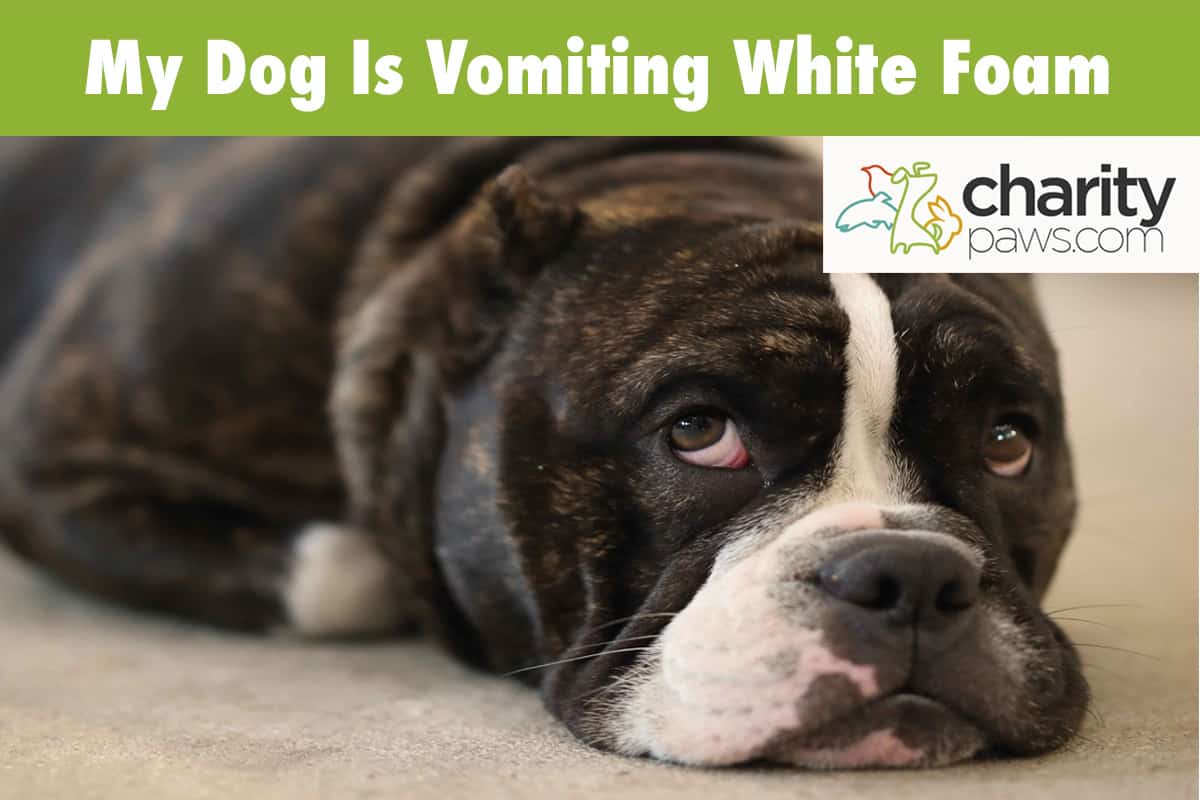Have you ever looked down at a fresh pile of vomit from your furry friend, only to discover a film of white foam on top?
Some dogs even vomit white foam entirely, causing their owners to wonder if this is a result of something serious.
The presence of white foam vomit in dogs is not a diagnosis in itself, but it is known to occur in a handful of medical complications.
To help you better understand your dog that’s vomiting white foam, we will talk about the many underlying factors below.

Is White Foam Vomit Different Than Other Forms Of Vomit In Dogs?
Before we discuss the potential causes of white foamy vomit in dogs, it’s important to first realize that white foam in your dog’s vomit doesn’t mean their situation is any more serious.
White foam in a dog’s vomit is just a result of the retching action that occurs as they attempt to expel the vomit, as this causes air to move in and out of their mouths.
“A dog retching will pull air in and out of their mouth as they vomit, causing the liquid to bubble up and create a foam-like appearance. This doesn’t make the situation any more severe, but it does often mean they are vomiting on an empty stomach.” – Dr. Amy Lewis BVSC MRCVS at WVS Care For Dogs
Just as blowing air through a straw would cause bubbles to form in your drink, this is no different when a dog vomits. If there is ever white foam or bubbles present in your dog’s throw up, it is most likely the result of air coming in contact with the liquid.
7 Possible Reasons Why Your Dog Is Vomiting White Foam
Now that you know why white foam can be present in your dog’s vomit, let’s discuss the most common conditions in which white foamy vomit is present. Ranging from a general upset stomach to acid reflux, we will list the potential causes below.
They Are Vomiting On An Empty Stomach
If your dog has not eaten for more than 10-12 hours for any reason, this can lead to white foam in their vomit if they are nauseous. The foam in their vomit is often most obvious when other food contents are not present, and their vomit may consist of mostly foam and bile.
In these cases we always suggest trying to get to the bottom of your dog’s empty tummy, whether they simply missed a meal or if they are refusing to eat.
They Are Experiencing Acid Reflux
Humans are not the only ones that suffer from acid reflux. Our dogs can develop acid reflux as well, and it may even be referred to as bilious vomiting syndrome.
These dogs will typically vomit in the morning after going all night without food, as they experience a build up of bile within the stomach overnight. The bile will then irritate their stomach lining, often causing the dog to vomit bile as soon as they wake up.
Because there is not any food in their stomach when this happens, you will typically see white foam.
If this is the case for your dog, most vets will recommend simply increasing your dog’s meals throughout the day by splitting up their standard feeding amount.
This limits the time between meals and the ability for acid to build up in the stomach, hopefully decreasing their nausea because of it. You can also offer your pup a late night snack before they go to sleep.
They Ate Something They Shouldn’t Have
When a dog eats something outside of their normal diet, this is often referred to as dietary indiscretion. Dogs have a complex gut flora that becomes accustomed to their standard food, and any sudden change in their diet can throw things off.
This sudden change can easily lead to an upset stomach in dogs, and may even cause a dog to shy away from food because of it. If your dog experiences nausea and vomiting because of their dietary indiscretion, you may see white foamy vomit.
Most dogs can improve with a short fasting period, only to be followed with a bland diet for 3-5 days.
However, if your dog’s GI upset does not improve within 24-hours, we suggest having them seen by a vet. Any worsening symptoms can point to the possibility of pancreatitis, and this requires immediate veterinary attention.
They Have Pancreatitis From Eating Fatty Human Food
As we mentioned above, pancreatitis is always a risk in dogs when they eat food outside of their normal diet. It most often develops after a dog eats fatty human food, which leads to acute inflammation of the pancreas.
Pancreatitis causes digestive fluids to leak out of the organ and to the surrounding tissue, which then causes severe abdominal pain. In addition to stomach pain, many dogs will also develop severe vomiting and diarrhea.
If your dog has a history of eating fatty food and is vomiting white foam, we always suggest having them seen by your vet. Pancreatitis is a serious medial condition that requires aggressive treatment, so it is never a good idea to sit on it.
They Have An Infectious Illness
Unfortunately, our pups are not immune to deadly diseases that can lead to the onset of vomiting. The most common gastrointestinal disease that causes GI upset in dogs is parvo, which is a deadly virus that attacks the GI tract.
Due to the damage that occurs to the GI system, these pups will develop severe gastrointestinal symptoms. The most common symptom of parvovirus in dogs include:
- Vomiting (What Does Parvo Vomit Look Like)
- Anorexia
- Diarrhea
- Bloody diarrhea
- Abdominal pain
- Gas
- Lethargy
- Weakness
Due to the fact that many dogs with parvo will not want to eat, they will often vomit up white foam or bile. Parvo virus is most common in very young dogs under 1 year of age, but it can occur in unvaccinated pups up to 4 years of age.
If your dog is not fully vaccinated and develops severe GI upset, we always suggest having them seen by a vet immediately.
They Have An Intestinal Obstruction
Intestinal obstructions are another dangerous cause of white foam vomit in dogs. Obstructions occur when a dog eats anything that is not easily broken down by their digestive process, causing the item or material to form a blockage along the GI tract.
This makes it impossible for other stomach and intestinal contents to pass, and also puts immense pressure on the spot in which the foreign body is located. If the blockage is not resolved with immediate veterinary treatment, it is often fatal.
Due to the fact that dogs cannot pass items from their stomach and through the intestines as they normally would, this typically leads to vomiting. Many dogs cannot eat due to the nausea they are experiencing, which increases the prevalence of foam in their vomit due to their tummy being empty.
They Have An Underlying Chronic Disease
And last, some dogs will vomit white foam due to an underlying disease of some kind.
Many chronic conditions lead to anorexia and vomiting in dogs, which increases the prevalence of white foamy vomit.
Some of the many underlying health conditions seen in dogs include:
- Kidney disease
- Liver disease
- Diabetes
- Cushing’s disease
- Heart disease
If your dog has any chronic symptoms that are concerning you, we always suggest reaching out to your vet for guidance. This is especially important in senior dogs, as they are more prone to chronic illness.
What Treatments Are There For A Dog Vomiting White Foam?

The treatment options for white foam vomit will vary based on the cause of their symptoms. For example, if your vet thinks it’s a simple case of acid reflux, they may instruct you on how to change their feeding routine and prescribe your dog antacid medications.
However, if your dog is battling something serious such as pancreatitis, their treatment may involve time in the hospital on intravenous fluids and injectable medications.
Due to how many factors can be behind your dog’s vomiting, we always suggest having your dog seen if they vomit more than once in a 24-hour period. This is especially true if they are having other concerning symptoms.
Once your vet gets to the bottom of your pup’s foamy vomit, they can determine the best treatment option.
Frequently Asked Questions On White Foam Vomit
When should I take my dog to the vet for vomiting white foam?
We always suggest having your dog seen if they vomit more than once over a 24-hour period. Vomiting is a common symptoms of many conditions, so frequent vomiting should always warrant a vet visit.
If my dog vomits once, but is otherwise fine, can I watch them at home?
If your dog only vomits once and seems fine after, then it is likely okay to just monitor them at home. Dogs can get simple upset stomachs like we can, so as long as they do not vomit again, they may be just fine.
My dog is trying to vomit but cannot produce anything. What could this mean?
Trying to vomit but being unable to produce anything can be a sign of bloat in dogs. This refers to when the stomach flips on itself inside the dog’s chest, which makes it impossible for anything to flow in or out of the stomach.
This condition also cuts off blood flow to the rest of the dog’s intestines, which is why it is a life threatening emergency. It is most common in deep chested dogs, but it can occur in any dog.
If your dog is experiencing an inability to vomit, distended abdomen, weakness, pale gums, weak pulse, and difficulty breathing, we suggest seeing a vet as soon as possible. Bloat progresses quickly in dogs so they require immediate medical intervention.
Resources:
1.) https://www.petmd.com/dog/conditions/digestive/c_dg_bilious_vomiting_syndrome
2.) https://www.akc.org/expert-advice/health/pancreatitis-in-dogs/

